Features of growing watermelons in Siberia in open ground: step-by-step instructions
The juicy flesh of watermelon is an excellent summer snack. When chilled, it is perfectly refreshing: it is both a dessert and an original drink. The sweet fruits are used to make delicious shakes, smoothies and lemonades. They are also added to salads, pickled, and made into jams and preserves. Unfortunately, watermelons sold in markets and stores do not always meet the requirements for product quality and safety.
Therefore, it is best to grow them yourself to be sure that the crop does not contain nitrates and harmful substances. Domestic and foreign breeders have developed many different varieties and hybrids of watermelon. Now the healthy delicacy is grown in open ground not only in the south, but also in the Urals and even in harsh Siberian conditions.
The topic of our article is growing watermelons in Siberia in open ground. You will learn which varieties are most suitable for the Siberian climate, how to properly prepare seeds and seedlings, how to feed the crops and when to harvest.
Features of growing watermelons in Siberia in open ground
Summer in Siberia is short and not very warm, so it is preferable to cultivate melons here using seedlings. Growing through seedlings protects tender shoots from return frosts and speeds up the ripening of the crop.
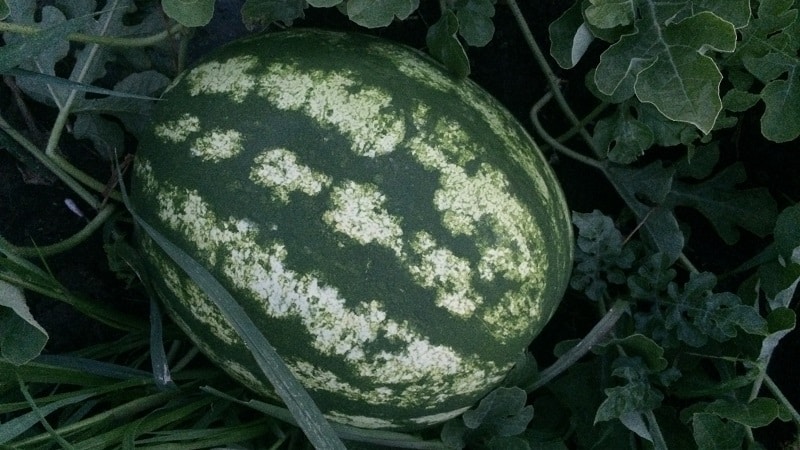
Weather
For residents of the European part of Russia, Siberia is associated with harsh climatic conditions. However, this statement is only partly true.After all, Siberia occupies a huge territory. Conventionally, it is divided into Western, Eastern and Northern.
Weather conditions in Western Siberia
The western part includes Omsk, Tomsk, Novosibirsk, Kemerovo regions, Altai Territory, the Republics of Khakassia and Altai. This region of Siberia is characterized by the mildest climate. In summer, the temperature is set in the range of +15…+35°C.
Weather conditions in Eastern Siberia
Eastern Siberia includes the Irkutsk region, the Republics of Tyva and Buryatia, and the Trans-Baikal Territory. The climate of Eastern Siberia is sharply continental. Summer is sunny and it rarely rains. Temperatures in the summer months average +15°C.
Weather conditions in the northern regions
In the northern territories of the Krasnoyarsk Territory, weather conditions are harsh. There is practically no summer in these parts. The temperature rarely rises above +10°C.
Thus, the climate of Western Siberia is most favorable for growing watermelons in open ground.
Suitable varieties of watermelons
The key to successfully growing a southern crop in unusual conditions is the correct choice of variety. Suitable for cultivation in Siberia in open ground early ripening varieties and watermelon hybrids. When choosing a variety, pay attention to its resistance to diseases and sudden temperature changes.
Pumpkins of early watermelons will not please you with their large size. But they will have time to ripen before the end of the short Siberian summer.
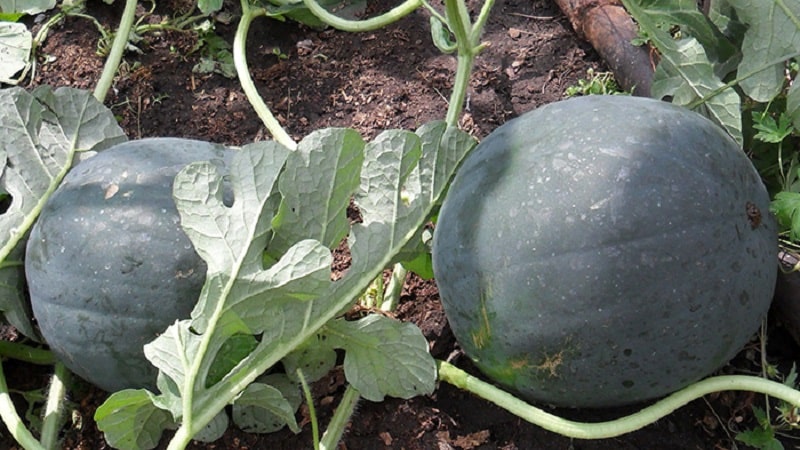
Popular varieties suitable for growing in Siberia include:
- Chill. An early ripening variety that tolerates low temperatures well. The growing season is 85–100 days. The weight of the fruit reaches 6-7 kg.
- Ultra early. The growing season is 80 days.The fruits are spherical, dark green, with thin sparse stripes over the entire surface. The weight of the fruit is 4–6 kg.
- Photon. Ripens in 80–100 days. The variety is undemanding to soil and resistant to diseases. The pulp is tender and juicy, with a moderate amount of seeds. Pumpkins weigh on average 3–6 kg.
- Siberian lights. The variety was bred specifically for cultivation in Siberia. Resistant to low temperatures, few sunny days and lack of moisture. The fruits are round, dark, without stripes. The weight of the fetus is 3-4 kg.
- Siberian giant. Also bred specifically for northern latitudes. It is distinguished by large fruits, cold-resistant, and stores well. The pulp is sweet and juicy.
Growing instructions
In Siberia, watermelons are cultivated in open ground through seedlings. Before transplanting plants into the garden bed, measure the soil temperature. The earth must be warmed up to at least +15°C. Also, before planting, you should make sure that the threat of return frosts has passed.
Advice. Before planting watermelon seedlings in open ground, measure the soil temperature. If the reading is +15°C or higher, proceed with planting.
Preparatory stage
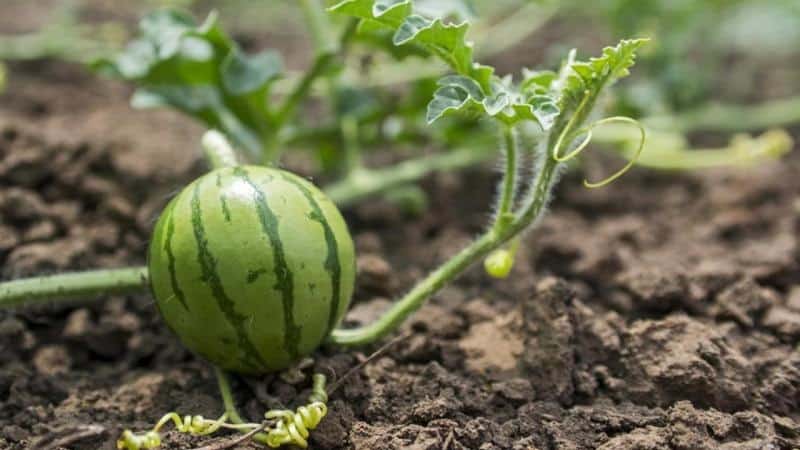
Preparation for planting includes seed and soil treatment.
Preparing seed material will speed up the emergence of seedlings and protect young plants from diseases. First, the seeds are wrapped in a damp cloth and kept there until they bite. Wet sawdust is also used for germination.
Treating seeds with a solution of potassium permanganate will destroy pathogenic bacteria and pathogens. The seeds are kept in the solution for half an hour and then washed with clean water. Now they are ready to plant.
A bed for melons is laid out in an open, sunny place. The earth is dug up and cleared of weeds.Additionally, fertilizers, compost, and humus are added.
Before planting, it is good to check the soil for acidity. An excess of iron, aluminum and manganese compounds leads to stunting and death of plants for no obvious reason.
Need to know. Acidic soils are neutralized with wood ash (at least 0.5 kg per 1 m²). In addition, the ash will provide the plants with calcium, magnesium, and phosphorus.
Watermelons are not planted in beds where legumes and cabbage used to grow. It makes no sense to plant watermelons after melons: zucchini, pumpkin, melon or the same watermelon.
Potatoes, onions, tomatoes, carrots and garlic are considered favorable predecessors.
Growing seedlings
Seeds for seedlings are sown at the end of April. If you do this earlier, the seedlings will overgrow and take root poorly.
Each seed is planted in a separate container (tetrapack, plastic or peat glass) with a volume of at least 0.6 liters.
The soil mixture used is loose, breathable, with the addition of humus and sand.
Attention. After sowing, the containers are placed in a warm place with a temperature of +30...+32°C. If the temperature is below +25°C, the emergence of seedlings will slow down. And if it is below +20°C, then the seeds will not sprout.
After the sprouts appear, the illumination of the plants is increased and the temperature is decreased. Optimal night indicators are +12…+14°С, and daytime indicators are +23…+25°С.
A couple of weeks after the plant sprouts feed. For this purpose, a complex water-soluble fertilizer is used. It is reapplied after 8–10 days.
Water the seedlings abundantly, but infrequently, using warm, settled water. After watering, the top layer of soil is loosened.
1-2 weeks before planting, the seedlings are transferred to a greenhouse, greenhouse or glassed-in balcony.There the plants will harden off and receive the maximum amount of sunlight.
Advice. If the seedlings have stretched out, add soil to the container to form additional roots. Or carefully bend the stem into a half ring and sprinkle with damp soil.
Planting in open ground
The specific date for planting seedlings in open ground is determined based on weather conditions and the location of the site. Approximate landing dates are from late May to mid-June. After planting, the plants are protected from temperature changes with covering material.
A few days before planting, the seedlings begin to harden, gradually increasing the time the plants spend in the air. If the night temperature does not drop below +10°C, the seedlings are left without shelter overnight.
The wells are prepared in advance. First, dig holes 0.5 m deep. Add 2 buckets of humus or compost, a third of a bucket of sand, 1 tbsp. l. double superphosphate and Kemira-Universal. Mix everything thoroughly.
The bottom of the hole is well watered and plants are planted. The distance between bushes is determined based on the recommendations of the seed manufacturer.
Attention. When planting seedlings, the earthen ball is not buried. It should rise above the ground surface by about 2 cm.
Care
After about two weeks, the plants will adapt to the new location and begin to grow. At this moment, the first feeding is carried out. To do this, use a solution of mullein, chicken manure (1:10), urea (30 g per 10 liters of water). After another couple of weeks, fertilizers are applied again. This time they use a solution of complex mineral fertilizer (30-40 g per 10 liters of water).
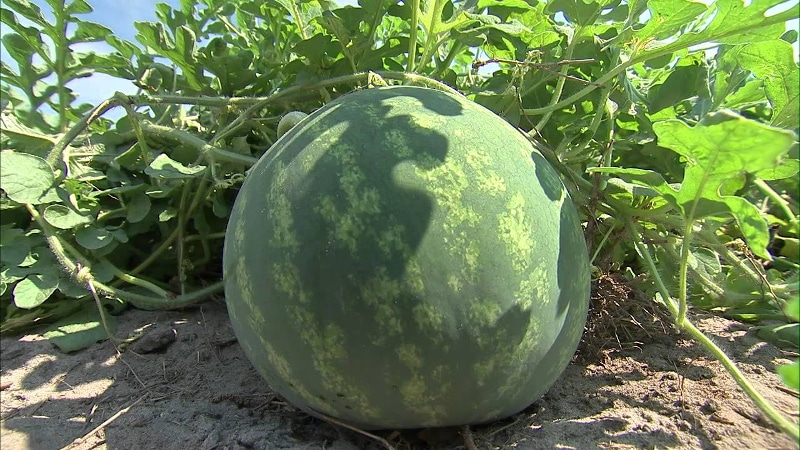 Water the plantings abundantly, but infrequently. Use only warm, settled water.Until the end of June, water approximately once a week, then once every 2 weeks, and from the beginning of August, watering is stopped. Excess moisture at the time of ripening reduces the amount of sugars in the fruit.
Water the plantings abundantly, but infrequently. Use only warm, settled water.Until the end of June, water approximately once a week, then once every 2 weeks, and from the beginning of August, watering is stopped. Excess moisture at the time of ripening reduces the amount of sugars in the fruit.
Possible problems during cultivation and ways to solve them
In the process of growing watermelons In open ground in Siberia, farmers are faced with damage to their crops by pests and the development of diseases. Let's look at these problems in more detail.
Diseases
Watermelon plantings are affected by the following diseases:
- Fusarium. This is a fungus that destroys the foliage and stems of the bush. As the disease progresses, the plant rots. The pathogen enters the bush through the roots. The most common cause of the disease is excess moisture in the soil.
- Anthracnose. Another fungal disease. It affects the foliage and lashes of the watermelon bush. Gradually, black spots form on the plant, the foliage dries out, and the fruits rot. The disease is transmitted through plant seeds and is also spread by spores through insects.
- Root rot. The disease is recognized by brown and black oozing spots. The leaves turn yellow, crack, and the root system is destroyed. The soil around the bush emits an unpleasant odor. In an advanced stage, the plant is removed and burned.
- Powdery mildew. It appears as a whitish coating on foliage, shoot tips, and fruit ovaries. Over time, the leaves turn brown and wounds appear on them. Watermelons stop growing and singing.
If rot or fungal disease is detected, the affected parts of the plant are removed and burned. The remaining bushes are sprayed with a fungicide solution. Spraying with chemicals is stopped a month before harvest.
Pests
Protecting watermelons from insects is important because they carry diseases.The danger comes from melon aphids, germ fly larvae, spider mites, wireworms, and thrips. To identify parasites, plantings are periodically inspected. A problem detected in time eliminates the need to spray plants with insecticides and chemicals.
Preventive measures
Prevention of the occurrence and development of diseases includes:
- compliance with cultivation conditions;
- selection of disease-resistant varieties;
- disinfection of soil and seed material;
- compliance with crop rotation rules;
- cleaning the area in the fall from plant debris;
- timely application of fertilizers and loosening of the soil.
Harvesting
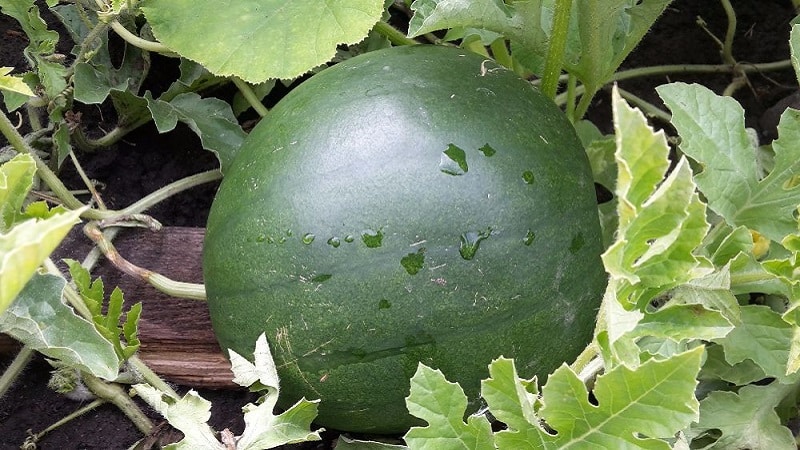
The watermelon harvest begins in August. Keep in mind that early ripening varieties are not intended for long-term storage. All fruits will have to be eaten soon or used for canning. The collected fruits of early varieties are stored for no more than 1.5 weeks.
Watermelons are removed from the garden as they ripen. Fruits from one plant are collected in 2-3 doses. Pumpkins are cut using a sharp knife or garden shears. It is undesirable to tear off the stalk with your hands - this leads to rotting of the fruit in this place.
The ripeness of watermelons is determined by their appearance. In a ripe fruit, the stalk, tendrils and leaves near the fruit dry out. This is a universal sign of ripeness for all pumpkin crops. In addition, when you tap the watermelon with your fingers, a dull, low sound is heard.
Advice from experienced farmers
For those who decided for the first time grow sweet fruits on your site, Advice from experienced farmers will be useful:
- For planting, choose a well-lit place, warmed by the sun throughout the day. Lack of sunlight will negatively affect the taste of the fruit - watermelons will be unsweetened.The accumulation of sugars directly depends on the intensity of photosynthesis.
- Plants should not be planted densely; bushes should be ventilated.
- Watermelon beds are watered moderately. Excessive moisture leads to the spread of root rot.
- The planting site is dug up in the fall and rotted manure is added. This will make it easier for the plant’s roots to penetrate into the deeper layers of the soil.
- The ideal option is to sow the area for watermelons in advance (1-2 years before planting) with winter wheat, perennial grasses, corn and dig them up at the stage of young plants, embedding them in the soil.
Conclusion
Growing southern crops, including watermelons, in the harsh Siberian climate is not an easy task. However, even in such climatic conditions, a decent harvest can be harvested. The main thing is to choose the variety correctly, grow strong, healthy seedlings, prepare the site and provide the plants with proper care.